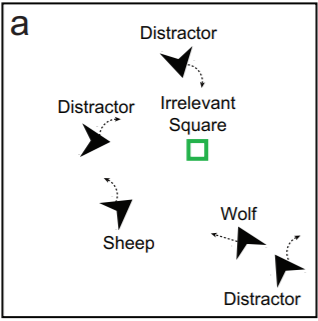The Wolfpack Effect: Perception of Animacy Irresistibly Influences Interactive Behavior

Abstract
Imagine a pack of predators stalking their prey. The predators may not always move directly toward their target (e.g., when circling around it), but they may be consistently facing toward it. The human visual system appears to be extremely sensitive to such situations, even in displays involving simple shapes. We demonstrate this by introducing the wolfpack effect, which is found when several randomly moving, oriented shapes (darts, or discs with “eyes”) consistently point toward a moving disc. Despite the randomness of the shapes’ movement, they seem to interact with the disc—as if they are collectively pursuing it. This impairs performance in interactive tasks (including detection of actual pursuit), and observers selectively avoid such shapes when moving a disc through the display themselves. These and other results reveal that the wolfpack effect is a novel “social” cue to perceived animacy. And, whereas previous work has focused on the causes of perceived animacy, these results demonstrate its effects, showing how it irresistibly and implicitly shapes visual performance and interactive behavior.
Demo1
Basic Demonstration of the Wolfpack Effect
Each dart moves randomly on the display, but is always oriented towards the disc (which is being moved about by a human controller).
Demo2
Basic Demonstration of the 'Perpendicular' Control for the Wolfpack Effect
The trajectories of the darts and the disc are identical, but now the darts are consistently oriented orthogonal to the disc. This greatly weakens or destroys the effect.
Demo3
Wolfpack condition (Search-For-Chasing Experiment)
Demo4
Wolfpack condition (Search-For-Chasing Experiment) [Cheat]
Demo5
Wolfpack condition (Don't-Get-Caught Experiment)
Demo6
Wolfpack condition (Don't-Get-Caught Experiment) [Cheat]
Demo7
Darts (Leave-Me-Alone Experiment)